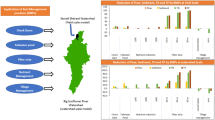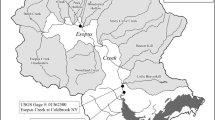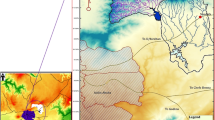Abstract
Evaluating the effectiveness of conservation practices (CPs) is an important step to achieving efficient and successful water quality management. Watershed-scale simulation models can provide useful and convenient tools for this evaluation, but simulated conservation practice effectiveness should be responsive to parameter values used to represent the practices in the modeling. The objectives of this study were to (1) assess the impacts of a set of conservation practices on hydrology and water quality of a watershed and (2) evaluate the sensitivity of Soil and Water Assessment Tool (SWAT) modeling outputs and simulated conservation practice effectiveness to parameters. The modeling study was conducted in an agricultural watershed, the subwatershed K (16.9 km2) of the Little River Experimental watershed located in the South Atlantic Coastal Plain of the USA. Sensitivity analysis showed that hydrologic response unit (HRU) and watershed-scale simulations for water quality were most sensitive to CN and FILTERW parameters. Load reduction rates as a function of increased aerial coverage of the conservation practices were greatest for total phosphorus (TP), followed by sediment and total nitrogen (TN). The results indicated that conservation practices would have a limited impact on stream flow volume but could have a significant impact on sediment and TP loads within this region. Watershed-scale TN and TP loads were also sensitive to an in-stream nutrient transformation process represented using the QUAL2E algorithm in SWAT. The study clearly demonstrated the most sensitive model parameters and the optimal conservation practices for this watershed.






Similar content being viewed by others
References
Arabi, M., Frankenberger, J. R., Engel, B. A., & Arnold, J. G. (2008). Representation of agricultural conservation practices with SWAT. Hydrological Processes, 22, 3042–3055.
Arnold, J. G., Muttiah, R. S., Srinivasan, R., & Allen, P. M. (2000). Regional estimation of base flow and groundwater recharge in the upper Mississippi river basin. Journal of Hydrology, 227, 21–40.
Asmussen, L. E., Sheridan, J. M., & Booram, C. V. (1979). Nutrient movement in streamflow from agricultural watersheds in the Georgia Coastal-Plain. Transactions of ASAE, 22, 809–815.
Beck, M. B. (1987). Water quality modelling: a review of the analysis of uncertainty. Water Resources Research, 23(8), 1393–1442.
Bosch, D. D., & Sheridan, J. M. (2007). Stream discharge database, Little River Experimental Watershed, Georgia, United States. Water Resources Research, 43, W09473. doi:10.1029/2006WR005833.
Bosch, D. D., Truman, C. C., Potter, T. L., West, L. T., Strickland, T. C., & Hubbard, R. K. (2012). Tillage and slope position impact on field-scale hydrologic processes in the South Atlantic Coastal Plain. Agricultural Water Management, 111, 40–52. doi:10.1016/j.agwat.2012.05.002.
Bosch, D. D., Sheridan, J. M., & Davis, F. M. (1999). Rainfall characteristics and spatial correlation for the Georgia Coastal Plain. Transactions of ASAE, 42, 1637–1644.
Bosch, D. D., Sheridan, J. M., Lowrance, R. R., Hubbard, R. K., Strickland, T. C., Feyereisen, G. W., & Sullivan, D. G. (2007a). Little River Experimental Watershed database. Water Resources Research, 43, W09470. doi:10.1029/2006WR005844.
Bosch, D. D., Sheridan, J. M., & Marshall, L. K. (2007b). Precipitation, soil moisture, and climate database, Little River Experimental Watershed, Georgia, United States. Water Resources Research, 43, W09472. doi:10.1029/2006WR005834.
Bosch, D. D., Potter, T. L., Truman, C. C., Bednarz, C. W., & Strickland, T. C. (2005). Surface runoff and lateral subsurface flow as a response to conservation tillage and soil-water conditions. Transactions of ASAE, 48, 2137–2144.
Chaplot, V., Saleh, A., Jaynes, D. B., & Arnold, J. G. (2004). Predicting water, sediment and NO3-N loads under scenarios of land-use and management practices in a flat watershed. Water, Air, and Soil Pollution, 154, 271–293.
Cho, J., Vellidis, G., Bosch, D. D., Lowrance, R. R., & Strickland, T. C. (2010). Water quality effects of simulated conservation practice scenarios in the Little River Experimental Watershed. Journal of Soil and Water Conservation Society, 65(6), 463–473.
Cho, J., Her, Y., & Bosch, D. (2015). Assessing applicability of SWAT calibrated at multiple spatial scales from field to stream. Journal of The Korean Society of Agricultural Engineers, 57(3), 21–39.
Dillaha, T. A. (1990). Role of best management practices in restoring the health of the Chesapeake Bay. In Perspectives on the Chesapeake Bay, 1990: Advances in Estuarine Sciences. Chesapeake Bay Program, CBP/TRS41/90. USEPA, WASHINGTON, DC.
Douglas-Mankin, K. R., Srinivasan, R., & Arnold, J. G. (2010). Soil and water assessment tool (SWAT) model: current developments and applications. Transactions of the ASABE, 53(5), 1423–1431.
Feyereisen, G. W., Lowrance, R. R., Strickland, T. C., Sheridan, J. M., Hubbard, R. K., & Bosch, D. D. (2007). Long-term water chemistry database, Little River experimental watershed, southeast coastal plain, United States. Water Resources Research, 43, W09474. doi:10.1029/2006WR005835.
Feyereisen, G. W., Strickland, T. C., Bosch, D. D., Truman, C. C., Sheridan, J. M., & Potter, T. L. (2008). Curve number estimates for conventional and conservation tillages in the southeastern coastal plain. Journal of Soil and Water Conservation, 63, 120–128.
Gassman, P. W., Reyes, M. R., Green, C. H., & Arnold, J. G. (2007). The soil and water assessment tool: historical development, applications, and future research directions. Transactions of the ASABE, 50, 1211–1250.
Gitau, M. W., Veith, T. L., Gburek, W. J., & Jarrett, A. R. (2006). Watershed level best management practice selection and placement in the town brook watershed, New York. Journal of the American Water Resources Association, 42, 1565–1581.
Green, C. H., Tomer, M. D., Di Luzio, M., & Arnold, J. G. (2006). Hydrologic evaluation of the soil and water assessment tool for a large tile-drained watershed in Iowa. Transactions of the ASABE, 49, 413–422.
Hubbard, R. K., & Sheridan, J. M. (1983). Water and nitrate-nitrogen losses from a small, upland, coastal plain watershed. Journal of Environmental Quality, 12(2), 291–295.
Hubbard, R. K., Berdanier, C. R., Perkins, H. F., & Leonard, R. A. (1985). Characteristics of selected upland soils of the Georgia Coastal Plain. U.S. Department of Agriculture, Agricultural Research Service. ARS-37.
James, L. D., & Burges, S. J. (1982). Selection, calibration, and testing of hydrologic models. In C. T. Haan, H. P. Johnson, & D. L. Brakensiek (Eds.), Hydrologic modeling of small watersheds. Michigan: ASAE Monograph. St. Joseph.
Jeong, J., Kannan, N., Arnold, J., Glick, R., Gosselink, L., & Srinivasan, R. (2010). Development and integration of sub-hourly rainfall–runoff modeling capability within a watershed model. Water Resources Management, 24(15), 4505–4527.
Larose, M., Heathman, G. C., Norton, L. D., & Engel, B. (2007). Hydrologic and atrazine simulation of the Cedar Creek watershed using the SWAT model. Journal of Environmental Quality, 36, 521–531.
Lenhart, T., Eckhardt, K., Fohrer, N., & Frede, H. G. (2002). Comparison of two different approaches of sensitivity analysis. Physics and Chemistry of the Earth, 27, 645–654.
Lowrance, R. R., Todd, R. L., Fail Jr., J., Hendrickson Jr., O., Leonard, R. A., & Asmussen, L. E. (1984b). Riparian forests as nutrient filters in agricultural watersheds. Bioscience, 34(6), 374–377.
Lowrance, R. R., Todd, R. L., & Asmussen, L. E. (1984a). Nutrient cycling in an agricultural watershed: II. Streamflow and artificial drainage. Journal of Environmental Quality, 13, 27–32.
Maresch, W., Walbridge, M. R., & Kugler, D. (2008). Enhancing conservation on agricultural landscapes: a new direction for the conservation effects assessment project. Journal of Soil and Water Conservation, 63(3), 198A–203A.
Mausbach, M. J., & Dedrick, A. R. (2004). The length we go—measuring environmental benefits of conservation practices. Journal of Soil and Water Conservation, 59, 96–103.
Neitsch, S. L., Arnold, J. G., Kiniry, J. R., & Williams, J. R. (2011). Soil and water assessment tool, theoretical documentation: version 2009. Texas water resources institute technical report no. 406. Temple: USDA Agricultural Research Service and Texas A&M Blackland Research Center.
Rawls, W. J., & Asmussen, L. E. (1973). Neutron probe field calibration for soils in Georgia Coastal-Plain. Soil Science, 116, 262–265.
Rawls, W. J., & Richardson, H. H. (1983). Runoff curve numbers for conservation tillage. Journal of Soil and Water Conservation, 38, 494–496.
Ryu, J., Cho, J., Kim, I. J., Mun, Y., Moon, J. P., Kim, N. W., Kim, S. J., Kong, D. S. & Lim, K. J. (2011). Enhancement of SWAT-REMM to simulate reduction of total nitrogen with riparian buffer. Transactions of the ASABE, 54(5), 1791–1798.
Saleh, A., Osei, E., Jaynes, D. B., Du, B., & Arnold, J. G. (2007). Economic and environmental impacts of LSNT and cover crops for nitrate-nitrogen reduction in Walnut Creek watershed, Iowa, using FEM and enhanced SWAT models. Transactions of the ASABE, 50, 1251–1259.
Saleh, A., Arnold, J. G., Gassman, P. W., Hauck, L. M., Rosenthal, W. D., Williams, J. R., & McFarland, A. M. S. (2000). Application of SWAT for the upper north Bosque River watershed. Transactions of ASAE, 43, 1077–1087.
Santhi, C., Srinivasan, R., Arnold, J. G., & Williams, J. R. (2006). A modeling approach to evaluate the impacts of water quality management plans implemented in a watershed in Texas. Environmental Modelling & Software, 21, 1141–1157.
Sheridan, J. M., Booram, C. V., & Asmussen, L. E. (1982). Sediment-delivery ratios for a small coastal-plain agricultural watershed. Transactions of ASAE, 25(3), 610–615.
Sheridan, J. M., Lowrance, R., & Bosch, D. D. (1999). Management effects on runoff and sediment transport in riparian forest buffers. Transactions of ASAE, 42(1), 55–64.
Sorooshian, S., & Gupta, V. K. (1995). Model calibration. In V. P. Singh (Ed.), Computer models of watershed hydrology. Highlands Ranch: Water Resources Publications.
Spruill, C. A., Workman, S. R., & Taraba, J. L. (2000). Simulation of daily and monthly stream discharge from small watersheds using the SWAT model. Transactions of ASAE, 43(6), 1431–1439.
Sullivan, D. G., & Batten, H. L. (2007). Little River Experimental Watershed, Tifton, Georgia, United States: a historical geographic database of conservation practice implementation. Water Resources Research, 43, W09475. doi:10.1029/2007WR006143.
Tong, S. T. Y., & Naramngam, S. (2007). Modeling the impacts of farming practices on water quality in the little Miami River basin. Environmental Management, 39, 853–866.
USDA, 2007. ARS benchmark watershed studies—Conservation Effects Assessment Project (CEAP). USDA Natural Resources Conservation Service. Available at: http://www.nrcs.usda.gov/Technical/NRI/ceap/ars.html. Accessed 15 January 2008.
USEPA, 2009. National Water Quality Inventory—report to congress: 2004 reporting cycle. EPA 841-R-08-001. USEPA, Office of Water, Washington D.C.
Vache, K. B., Eilers, J. M., & Santelmann, M. V. (2002). Water quality modeling of alternative agricultural scenarios in the US corn belt. Journal of the American Water Resources Association, 38, 773–787.
Van Liew, M. W., Veith, T. L., Bosch, D. D., & Arnold, J. G. (2007). Suitability of SWAT for the conservation effects assessment project: comparison on USDA Agricultural Research Service watersheds. Journal of Hydrologic Engineering, 12, 173–189.
White, K. L., & Chaubey, I. (2005). Sensitivity analysis, calibration, and validations for a multisite and multivariable SWAT model. Journal of the American Water Resources Association, 41(5), 1077–1089.
Author information
Authors and Affiliations
Corresponding author
Rights and permissions
About this article
Cite this article
Cho, J., Her, Y. & Bosch, D. Sensitivity of Simulated Conservation Practice Effectiveness to Representation of Field and In-Stream Processes in the Little River Watershed. Environ Model Assess 22, 159–173 (2017). https://doi.org/10.1007/s10666-016-9530-6
Received:
Accepted:
Published:
Issue Date:
DOI: https://doi.org/10.1007/s10666-016-9530-6




